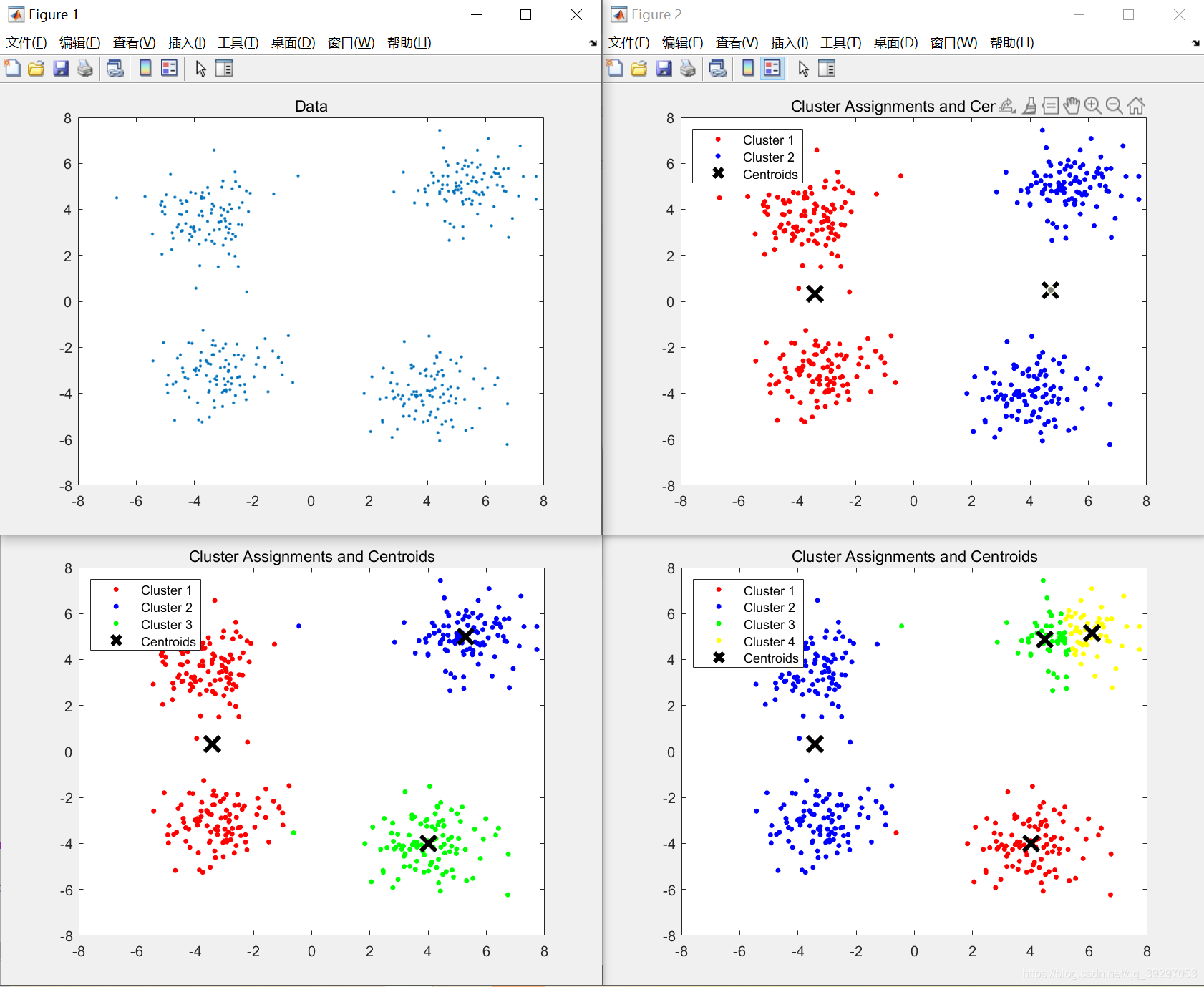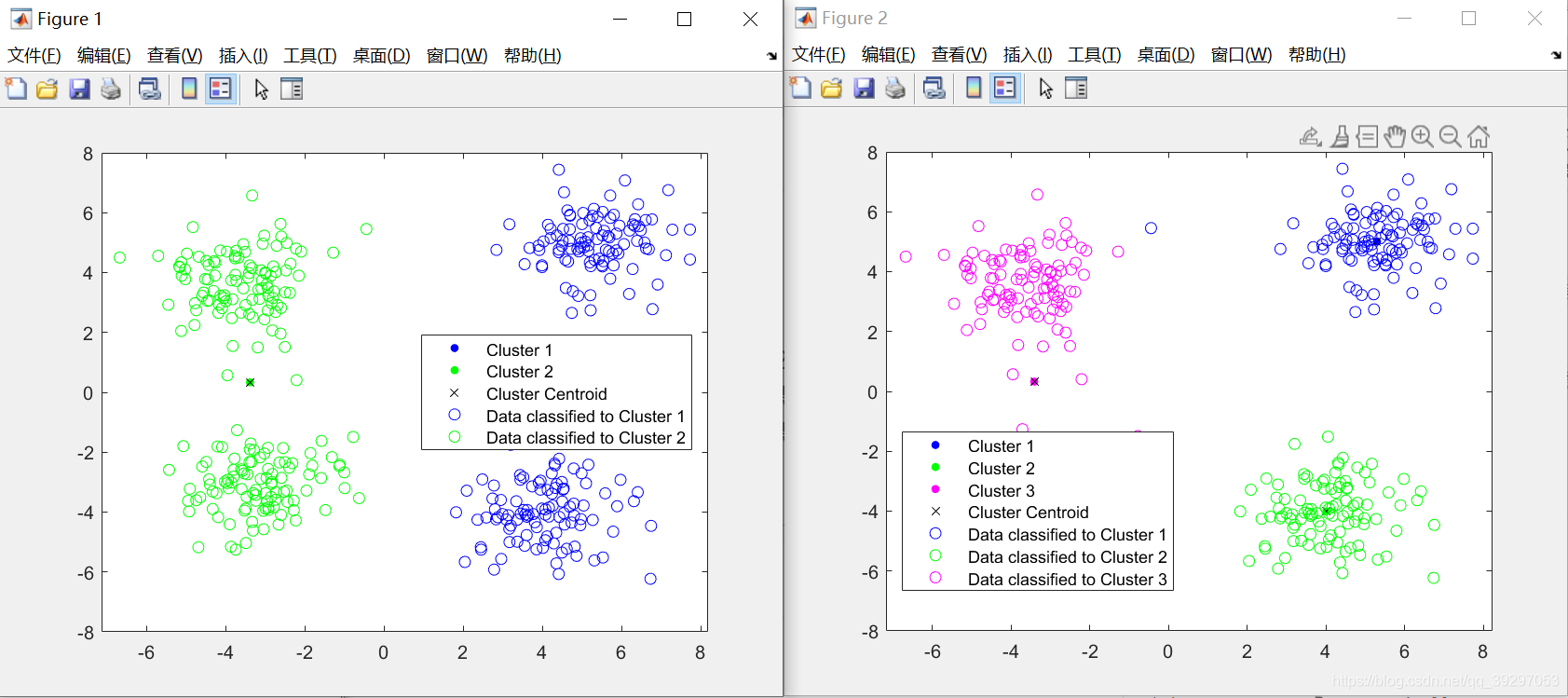项目场景:
使用matlab中的kmeans命令对数据进行聚类。
问题描述1:
将data1加载到Matlab环境中,并使用“ plot”命令显示数据。 然后通过使用K-means聚类算法(matlab中的“ kmeans”命令),将数据分为2、3和4组,并以不同的颜色显示其中心的聚类数据
命令介绍:
MATLAB函数Kmeans
使用方法:
Idx=Kmeans(X,K)
[Idx,C]=Kmeans(X,K)
[Idx,C,sumD]=Kmeans(X,K)
[Idx,C,sumD,D]=Kmeans(X,K)
[…]=Kmeans(…,’Param1’,Val1,’Param2’,Val2,…)
各输入输出参数介绍:
X: NP的数据矩阵,N为数据个数,P为单个数据维度
K: 表示将X划分为几类,为整数
Idx: N1的向量,存储的是每个点的聚类标号
C: KP的矩阵,存储的是K个聚类质心位置
sumD: 1K的和向量,存储的是类间所有点与该类质心点距离之和
D: N*K的矩阵,存储的是每个点与所有质心的距离
[…]=Kmeans(…,‘Param1’,Val1,‘Param2’,Val2,…)
这其中的参数Param1、Param2等,主要可以设置为如下:
- ‘Distance’(距离测度)
‘sqEuclidean’ 欧式距离(默认时,采用此距离方式)
‘cityblock’ 绝度误差和,又称:L1
‘cosine’ 针对向量
‘correlation’ 针对有时序关系的值
‘Hamming’ 只针对二进制数据 - ‘Start’(初始质心位置选择方法)
‘sample’ 从X中随机选取K个质心点
‘uniform’ 根据X的分布范围均匀的随机生成K个质心
‘cluster’ 初始聚类阶段随机选择10%的X的子样本(此方法初始使用’sample’方法)
matrix 提供一K*P的矩阵,作为初始质心位置集合 - ‘Replicates’(聚类重复次数) 整数
解决方案:
matlab代码
load('C:\Users\86177\Desktop\新建文件夹\matlab\data1.mat')
figure;
plot(X(:,1),X(:,2),'.');
title 'Data';
[idx,C] = kmeans(X,2);
C2=C;
figure;
plot(X(idx==1,1),X(idx==1,2),'r.','MarkerSize',12)
hold on
plot(X(idx==2,1),X(idx==2,2),'b.','MarkerSize',12)
plot(C(:,1),C(:,2),'kx',...
'MarkerSize',15,'LineWidth',3)
legend('Cluster 1','Cluster 2','Centroids',...
'Location','NW')
title 'Cluster Assignments and Centroids'
hold off
[idx,C] = kmeans(X,3);
C3=C;
figure;
plot(X(idx==1,1),X(idx==1,2),'r.','MarkerSize',12)
hold on
plot(X(idx==2,1),X(idx==2,2),'b.','MarkerSize',12)
hold on
plot(X(idx==3,1),X(idx==3,2),'g.','MarkerSize',12)
plot(C(:,1),C(:,2),'kx',...
'MarkerSize',15,'LineWidth',3)
legend('Cluster 1','Cluster 2','Cluster 3','Centroids',...
'Location','NW')
title 'Cluster Assignments and Centroids'
hold off
[idx,C] = kmeans(X,4);
C4=C;
figure;
plot(X(idx==1,1),X(idx==1,2),'r.','MarkerSize',12)
hold on
plot(X(idx==2,1),X(idx==2,2),'b.','MarkerSize',12)
hold on
plot(X(idx==3,1),X(idx==3,2),'g.','MarkerSize',12)
hold on
plot(X(idx==4,1),X(idx==4,2),'y.','MarkerSize',12)
plot(C(:,1),C(:,2),'kx',...
'MarkerSize',15,'LineWidth',3)
legend('Cluster 1','Cluster 2','Cluster 3','Cluster 4','Centroids',...
'Location','NW')
title 'Cluster Assignments and Centroids'
hold off效果展示

问题描述2:
将每个聚类的中心用作训练数据,并对k = 2和3使用KNN算法对上述数据进行分类,并以不同的颜色显示分类的数据。
命令介绍:
MATLAB函数pdist2
1.pdist2(X)
D = pidst(X)主要计算X的行的距离,例如输入X为mn的矩阵,输出D为m(m-1)/2的向量,计算方法如下例子:
X=[1,2;3,4;5,1] 3*2的矩阵;
pdist(X)计算结果为[2.8284,4.1231,3.6056];
计算方法为第二行与第一行距离(3-1)(3-1)+(4-2)(4-2)得到的结果开平方为2.8284,第三行与第一行距离(5-1)(5-1)+(1-2)(1-2)得到的结果开平方为4.1231,第三行与第二行距离(5-3)(5-3)+(1-4)(1-4)得到的结果开平方为3.6056.
2.pdist(X, Y)
X为ab矩阵,Y为cb矩阵,矩阵的每一行代表一个元素,返回一个a*c矩阵,代表X,Y任意两个元素之间的距离。
解决方案:
matlab代码(接上部分)
[idx,C] = kmeans(C2,2);
figure
gscatter(C2(:,1),C2(:,2),idx,'bgm')
hold on
plot(C(:,1),C(:,2),'kx')
legend('Cluster 1','Cluster 2','Cluster Centroid')
Xtest =X;
[~,idx_test] = pdist2(C,Xtest,'euclidean','Smallest',1);
gscatter(Xtest(:,1),Xtest(:,2),idx_test,'bgm','ooo')
legend('Cluster 1','Cluster 2','Cluster Centroid', ...
'Data classified to Cluster 1','Data classified to Cluster 2' )
%**************************************************
[idx,C] = kmeans(C3,3);
figure
gscatter(C3(:,1),C3(:,2),idx,'bgm')
hold on
plot(C(:,1),C(:,2),'kx')
legend('Cluster 1','Cluster 2','Cluster 3','Cluster Centroid')
Xtest =X;
[~,idx_test] = pdist2(C,Xtest,'euclidean','Smallest',1);
gscatter(Xtest(:,1),Xtest(:,2),idx_test,'bgm','ooo')
legend('Cluster 1','Cluster 2','Cluster 3','Cluster Centroid', ...
'Data classified to Cluster 1','Data classified to Cluster 2', ...
'Data classified to Cluster 3')效果展示








评论(0)
您还未登录,请登录后发表或查看评论